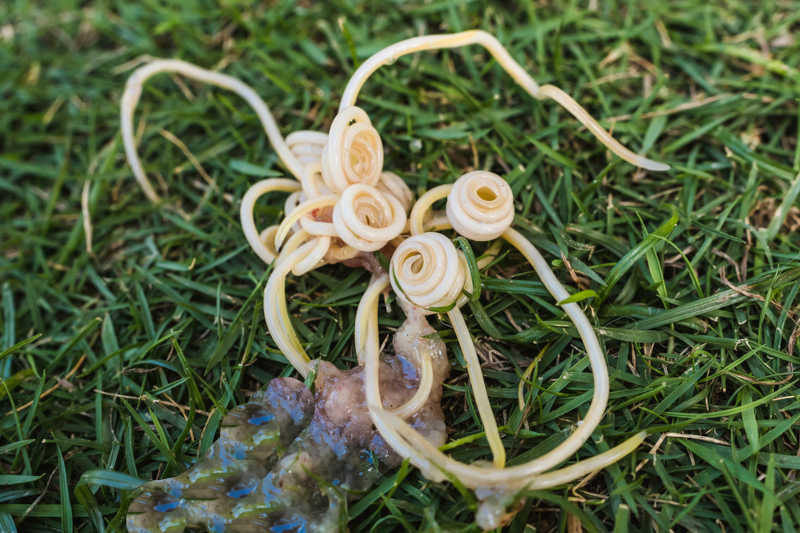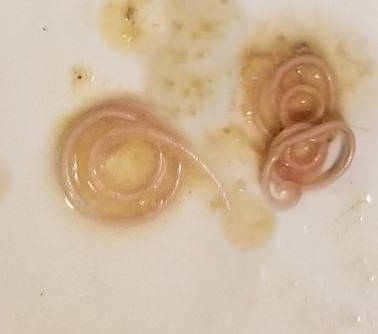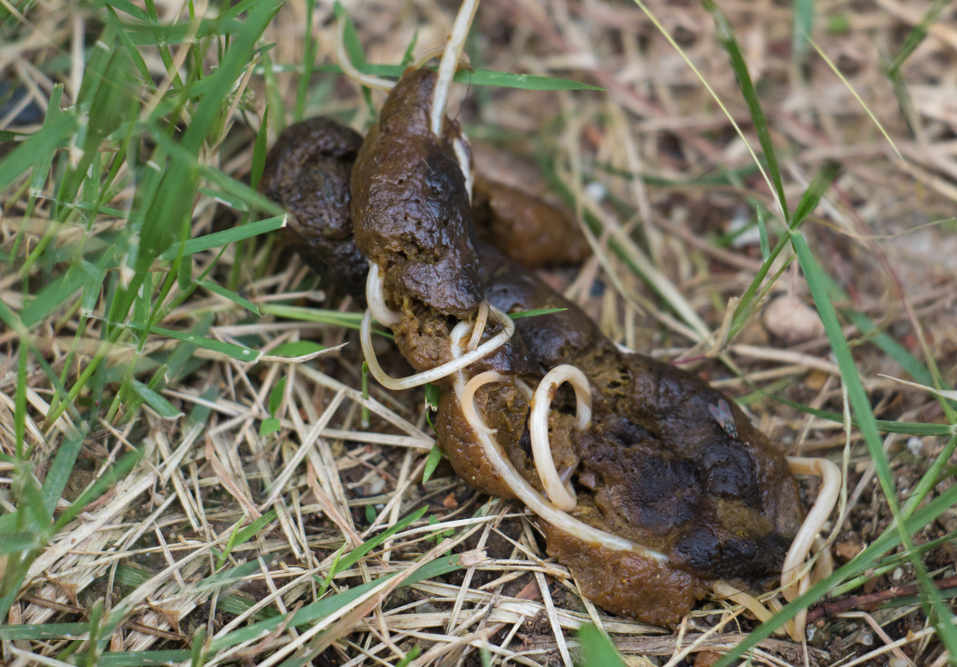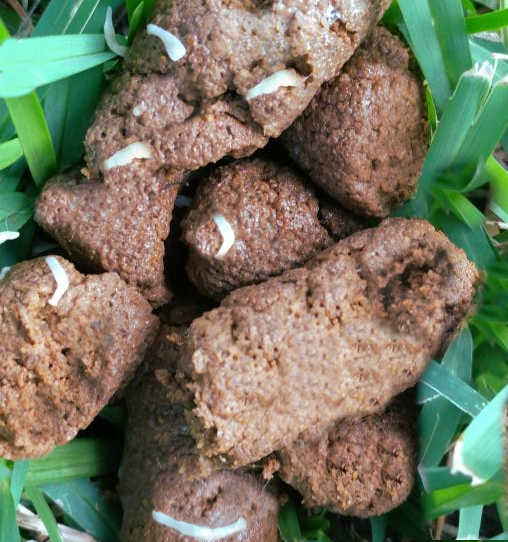
This article was updated on October 31st, 2023

Intestinal worms are an unsightly yet very common problem in dogs and cats. Knowing how to recognize and prevent intestinal parasites is an essential part of your dog’s care. To help you with this, our veterinarians have created this visual guide with pictures of worms in a dog’s vomit.
The most commonly found worm in a dog’s vomit is called roundworm
“Dogs have four common intestinal worm parasites: roundworm, hookworm, whipworm, and tapeworm. Roundworms are the most common intestinal parasite to see in vomit.”
On occasion, adult tapeworms detach from the intestinal wall and migrate to the stomach, where they can then be vomited up. You will rarely see hookworms or whipworms in vomit, although all of these can also cause upset stomach and vomiting.
What it looks like [with pictures]
Since most worms seen in dog vomit are roundworms, the color is usually white, light brown, or pale yellow. A roundworm typically appears as a long, thin, worm that resembles spaghetti, as shown on the images below.

How long are the typical worms seen in the dog’s vomit? They are typically white, thick roundworms that vary between 4-6 inches long. Less commonly, dogs can vomit tapeworms, which can be up to 11 inches.

“Dogs vomiting worms usually have a heavy worm burden & need veterinary help.”
Below is a picture of Toxocara canis, a species of roundworm that can infect people and dogs:

“Take a picture or, even better, put the worms in a bag or container and show it to your veterinarian.”
If you see something black or red, it likely is NOT an intestinal parasite. More than likely, what you see in the vomit is something your dog ate, like a stick or toy. It’s still worth collecting the sample to show to your veterinarian (at a minimum, remember to take a picture).
Be sure to also inspect your dog’s stool
If your dog has worms, you will likely see them in your dog’s stool as they pass out of the intestines (read our article with Pictures of Worms in Dog Poop). If the worm or its immature larval stage has migrated into our tissues, your dog may also cough or vomit up worms.
Is it worms, or is it something else in my dog’s vomit?
While it seems like it should be obvious whether it is a worm in your dog’s vomit or not, it isn’t always so clear. Once something has been vomited up, it never seems quite as evident what it was in the first place!
Sometimes dogs will vomit pieces of toys, cloth, or sticks and string that may look like worms. Remember, most intestinal parasites are an off-white, yellow, or very light brown color. If you see something darker, take another look – it may be something else!
When should you call the vet?
In general, dogs vomiting worms have a heavy worm burden and should be treated by a veterinarian as soon as possible. This is particularly true if:
- your dog is lethargic,
- your dog is not eating,
- your dog vomited numerous worms.
If your dog is still eating and drinking normally and has a good energy level, monitor your dog and make an appointment with your vet in the next couple of days.
Worms can make an adult dog sick but can often be serious – even life-threatening – for puppies since they have a weaker, immature immune system.
Learn more about treating dogs who have just vomited worms.
Typical Symptoms in Dogs with Intestinal Parasites
It’s important that you monitor for the following signs in your dog:
- Diarrhea or soft stool
- Dull coat
- Poor growth, especially in puppies
- Potbelly appearance
- Scooting, especially with tapeworms
- Vomiting
- Weight loss
- Coughing
Below are pictures of worms in dog’s stools.


Prevention with routine deworming once a year
The best way to make sure your dog doesn’t vomit worms is to prevent them in the first place. Routine deworming at least once a year is recommended.
Talk to your veterinarian about doing a fecal test and deworming at your dog’s yearly checkup. Your vet can also tell you about a variety of preventative dewormers. Many oral heartworm medications now help prevent a variety of intestinal parasites as well.
Hygiene – both for you, your family, and your dog – is also extremely important. Make sure to clean up the yard and any feces as quickly as possible to minimize any worms or infective eggs being left on the ground. Try not to let pets use the bathroom in areas that small children play in since they are more at risk for contracting intestinal parasites.
Frequently Asked Questions
What are the chances of getting worms from your dog?
- Roundworm: The roundworm Toxocara canis can be passed to people that accidentally ingest eggs in infested soil or feces.
- Tapeworm: The most common tapeworm in dogs, Dipylidium spp., does not infect humans; less common tapeworm species, Echinococcus, can infect humans but are rare in the United States.
- Whipworm: The whipworm is unique to dogs and cats, and they do not infect humans.
- Hookworms: Immature stages can cross through human skin (often when stepped on in infected environments). The immature larvae do not develop into adult worms but can cause organ damage.
Can worms cause a dog to vomit?
Finding a worm in your dog’s vomit is rare, but it is still possible. It is far more likely that you will see worms in your dog’s stool. Since puppies and young dogs are more likely to be sick from intestinal parasites, they may be more likely to have associated vomiting.
Do worms in dogs cause them to be in pain?
Worms can cause symptoms like vomiting, diarrhea, and abdominal pain if they are in the intestines in high enough numbers. Tapeworms can also cause discomfort and scooting due to the rice-like proglottid segments that pass through the rectum and get stuck in the fur around the dog’s anus.
How long will a dog throw up worms? Will it go away on its own?
It will likely NOT go away on its own. A worm in vomit means your dog likely has a high worm burden (or large numbers). They can vomit from an upset stomach but can also vomit due to obstruction by many worms.
How did my dog get worms?
Your dog can get them in various ways; transmission depends on the type of worm.
Roundworms – ingesting or sniffing eggs off the ground or eating infected rodents, birds, and earthworms. Larvae can cross the placenta, infect unborn puppies, and pass through the mother’s milk to new puppies.
Tapeworms – ingesting a tapeworm-infected flea. Once the dog’s intestines digest the tapeworm-infected flea, the tapeworm egg hatches and attaches to the intestinal wall. It can then grow and pass on its proglottid segments in the dog’s feces.
Whipworms – A dog is infected by eating mature eggs found in the environment. The egg then hatches and matures in the dog’s intestinal tract.
Hookworms – Dogs get hookworms by ingesting hookworm larvae in the environment, licking larvae off their paws, and through the mother’s milk and placenta.
Related posts:
Disclaimer: This website's content is not a substitute for veterinary care. Always consult with your veterinarian for healthcare decisions. Read More.












Be the first to comment